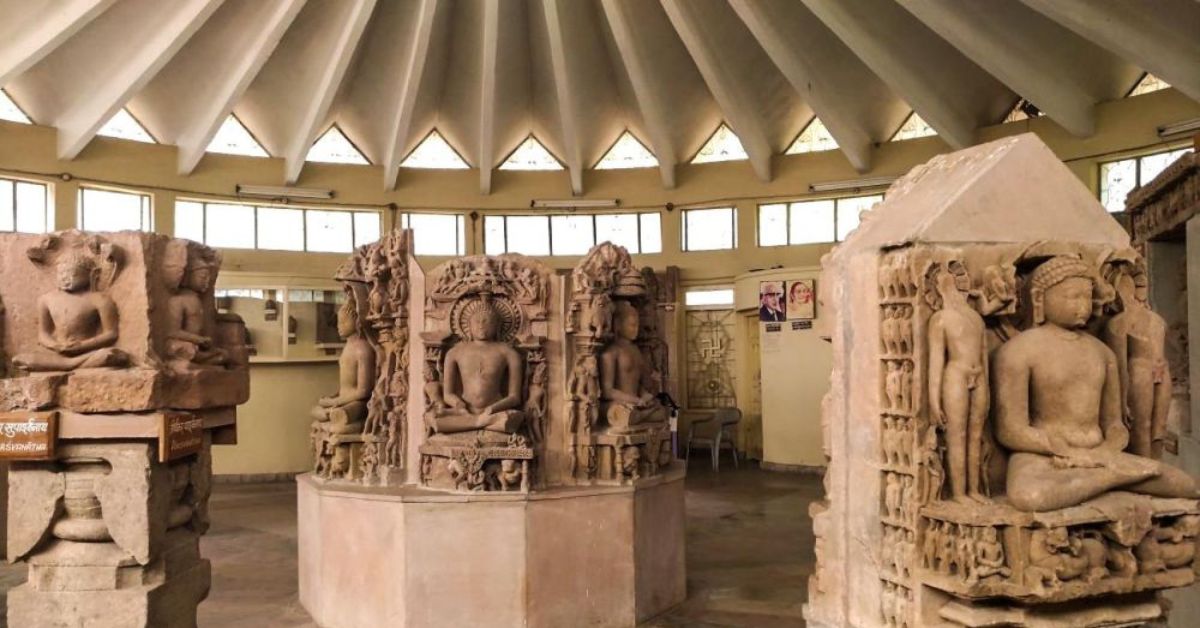The Wonders of Khajuraho Temples: Your Comprehensive Travel Guide – Exploring Divine Sculptures and Architectural Marvels
Immerse yourself in the heart of Madhya Pradesh, where the majestic Khajuraho Temples stand as a testament to a bygone era. Built by the Chandela dynasty between the 9th and 11th centuries, these architectural marvels are adorned with exquisite carvings and intricate sculptures. Each piece offers a captivating glimpse into India’s rich cultural tapestry.
Khajuraho’s true distinction lies in its remarkably detailed sculptures. These artworks depict a captivating narrative of life, spirituality, and mythology. Their beauty and sophistication have earned Khajuraho a well-deserved spot on the UNESCO World Heritage list, attracting travelers worldwide.
How to reach
By Air
- Cost: Flights from Delhi to Khajuraho typically range from INR 3,000 to 8,000 ($40 to $110) depending on the booking time and airline.
By Train
- Cost: Train fares from Delhi to Khajuraho range from INR 500 to 1,500 ($7 to $20) for non-air conditioned sleeper class, and INR 1,500 to 3,000 ($20 to $40) for air-conditioned class.
By Road
- Cost:
- Delhi to Khajuraho: Fuel costs around INR 5,000 to 8,000 ($70 to $110) for a round trip, including toll charges.
- Jhansi to Khajuraho: Fuel costs approximately INR 1,500 to 2,500 ($20 to $35) round trip, including toll charges.
- Varanasi to Khajuraho: Fuel costs around INR 3,500 to 6,000 ($50 to $85) round trip, including toll charges.
These costs are approximate and can vary based on vehicle efficiency, fuel prices, and specific travel conditions.
Best time to visit
Pleasant Winters (October to March): Arguably the best time to visit, winter offers comfortable temperatures ranging from 8°C to 27°C. Explore the temples without breaking a sweat, and immerse yourself in the beauty of the carvings. February brings a special treat – the Khajuraho Dance Festival, a vibrant showcase of classical Indian dances against the majestic temple backdrop.
Scorching Summers (April to June): The summer sun can be relentless, with temperatures climbing between 24°C and a scorching 45°C. Sightseeing becomes a challenge in the intense heat. However, if you do find yourself here during summer, plan your temple visits for the cooler mornings or evenings.
Lush Monsoon (July to September): The monsoon transforms into a verdant paradise, with moderate to heavy rainfall bringing temperatures down to a range of 22°C to 34°C. While the lush greenery is captivating, heavy rains can disrupt travel plans and make exploring the temples slippery and challenging. Pack rain gear and be prepared for unpredictable weather.
The Khajuraho Temples
Western Group of Temples, Khajuraho Temples
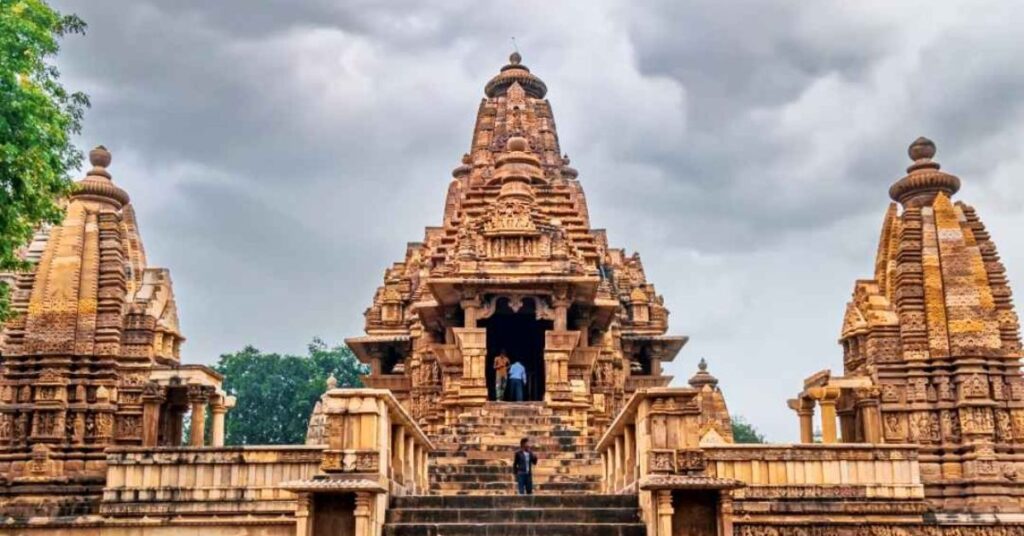
Undoubtedly the star attraction in Khajuraho, the Western Group of Temples is a UNESCO World Heritage Site that enthralls visitors worldwide. Within this cluster, the magnificent Kandariya Mahadeva Temple reigns supreme. Dedicated to Lord Shiva, it’s a masterpiece of Chandela architecture. Imagine a towering spire reaching for the heavens, resembling Mount Kailash, the abode of Shiva. Step inside, and marvel at the thousands of exquisite carvings that depict a captivating world of gods, goddesses, celestial beings, and mythical creatures.
Another gem of the Western Group is the Lakshmana Temple, dedicated to Lord Vishnu. Its facade is a veritable storybook, adorned with intricate friezes that bring to life scenes from the epic Hindu tales of Ramayana and Mahabharata. Don’t miss the Devi Jagadambi Temple, initially dedicated to Vishnu but later transformed into a shrine for the powerful Goddess Jagadambi.
Eastern Group of Temples
Step eastward discover a unique tapestry of faiths. The Eastern Group of Temples comprises both Hindu and Jain structures, offering a fascinating contrast in religious art and architectural styles.
Dominating the complex is the Parsvanath Temple, the largest Jain temple here. Dedicated to the Jain Tirthankara Parshvanatha, it’s a treasure trove of exquisite sculptures. Imagine celestial nymphs, graceful dancers, and lively musicians adorning the walls. But this isn’t just about heavenly beings. The temple also depicts everyday scenes, offering a glimpse into the lives and times of the Chandela people.
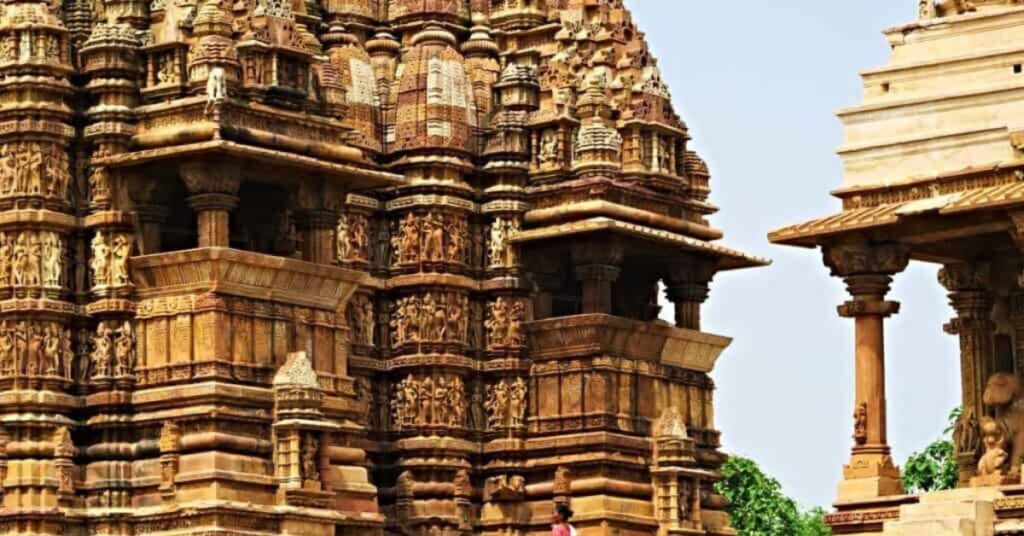
Southern Group of Temples
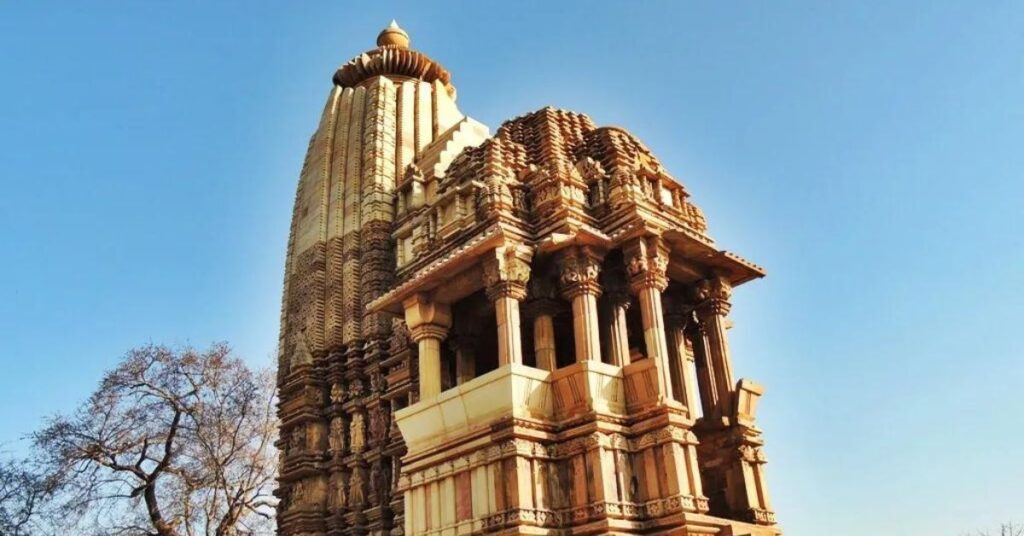
While the Western and Eastern Groups steal the spotlight, the Southern Group of Temples in Khajuraho holds its own charm. Though smaller and less crowded, it boasts significant structures that shouldn’t be missed.
Step into the Duladeo Temple, dedicated to Lord Shiva. Prepare to be mesmerized by its detailed sculptures of apsaras, celestial nymphs known for their beauty, and other divine figures. Built during the later reign of the Chandela dynasty, this temple showcases the continuous evolution of Khajuraho’s architectural and sculptural styles.
Archaeological Museum
Established in 1910, the Khajuraho Archaeological Museum is a treasure trove waiting to be explored. Here, you’ll find an impressive collection of sculptures, artifacts, and relics salvaged from the Khajuraho temples. Stepping into the museum is like taking a trip back in time, offering a deeper understanding of the historical and cultural significance of this UNESCO World Heritage Site.
The exhibits span various periods of the Chandela dynasty, showcasing the artistic evolution over time. Imagine beautifully carved statues of Hindu deities, celestial beings, and mythological figures that once adorned the temples. These intricate pieces come alive before your eyes, offering a glimpse into the artistic mastery of the Chandela era.
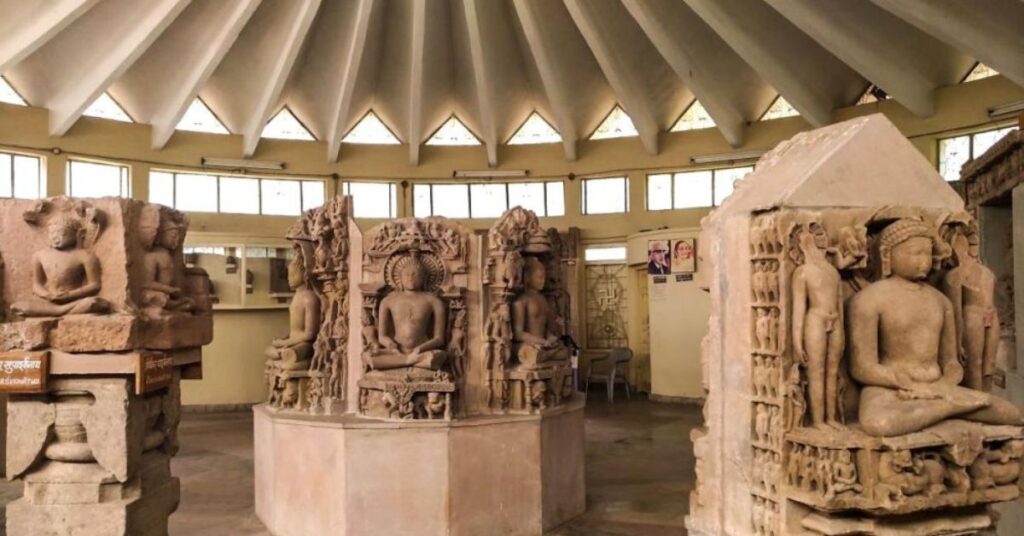
Local Experiences
- Guided Temple Tours: Unlock the secrets of the temples with a knowledgeable local guide. Their insights will bring history to life, revealing fascinating stories and hidden details you might miss on your own.
- Village Explorations: Venture beyond the main town and explore nearby villages. Immerse yourself in the local way of life, chat with friendly residents, and witness traditional crafts and agricultural practices firsthand.
- Dance Extravaganza: Witness the magic of the annual Khajuraho Dance Festival in February. Under the mesmerizing glow of illuminated temples, classical Indian dance performances come alive, showcasing the rich artistic heritage of India.
- Two-Wheeled Adventures: Rent a bicycle and explore Khajuraho at your own pace. Cycle through scenic landscapes and village roads, enjoying a unique and eco-friendly way to discover the town and its surroundings.
- A Culinary Journey: Embark on a flavor adventure by indulging in local Madhya Pradesh cuisine. Sample traditional dishes like poha, jalebi, and an array of curries and breads at local restaurants or street food stalls.
- Evening Aarti: Experience the serenity of the aarti (prayer ceremony) at the Matangeshwar Temple. Witness the locals in their daily worship and immerse yourself in the peaceful and sacred ambiance.
- Shopping Spree: Browse local markets and shops for unique treasures. Look out for handcrafted souvenirs, textiles, and stone carvings that reflect the region’s cultural heritage. Tribal art and handcrafted jewelry are also excellent finds.
- Light and Sound Spectacle: Attend the enthralling Light and Sound Show at the Western Group of Temples. This captivating presentation brings the history and legends of Khajuraho to life in a dramatic and engaging way.
- Capture Memories: Don’t forget your camera! Khajuraho’s stunning temples, vibrant landscapes, and daily life offer endless opportunities for photography. Early mornings and late afternoons provide the best lighting conditions.
- Inner Peace: Find tranquility by joining a yoga or meditation session at a local ashram or wellness center. Khajuraho’s tranquil environment provides the perfect setting for spiritual practices and rejuvenation.
- Cultural Delights: Immerse yourself in the region’s vibrant culture by attending local performances. Look for events at theaters or open-air venues that showcase traditional music and dance forms beyond the renowned dance festival.
- Birdwatching Paradise: For nature enthusiasts, Khajuraho offers excellent birdwatching opportunities. Explore the natural surroundings and nearby wildlife sanctuaries to spot a variety of bird species.
Travel tips
- Plan in Advance: Khajuraho is a magnet for tourists, especially during winter and the Dance Festival. Booking your accommodation and transportation well in advance will guarantee the best options.
- Dress for the Season: Khajuraho’s weather varies. Pack light, breathable clothing for hot summers and bring warm layers for cooler winters. Comfortable walking shoes are a must for exploring the temples and surroundings.
- Hydration is Key: Especially in the summer heat, carry a reusable water bottle and stay hydrated while exploring the sprawling temple complexes.
- Respect the Culture: When visiting temples and religious sites, dress modestly and be mindful of local customs. Remember to remove your shoes before entering temple grounds.
- Local Knowledge is Power: Consider hiring a knowledgeable local guide. Their insights into the history, architecture, and cultural significance of the temples will significantly enrich your experience.
- Cash on Hand: While ATMs and card payments are becoming more common, carrying some cash is recommended for smaller purchases, local markets, and tipping.
- Responsible Photography: Photography is allowed in most temple complexes, but be respectful. Avoid using flash in sensitive areas and always ask permission before photographing locals.
- Safety First: Khajuraho is generally safe, but basic precautions are wise. Avoid unlit areas at night and keep your belongings secure.
- Venture Beyond the Temples: While the temples are the highlight, don’t miss out on exploring local life! Consider village walks, cycling tours, and indulging in the region’s delicious cuisine.
- Immerse Yourself in Culture: If your visit coincides with the Khajuraho Dance Festival or other cultural events, attending these performances is a fantastic way to experience the region’s rich heritage firsthand.
- Stay Healthy: Pack a basic first-aid kit and any necessary medications. Using hand sanitizer and drinking only bottled or purified water helps avoid preventable health issues.
Conclusion
Unveil the captivating tapestry of India at Khajuraho, a UNESCO World Heritage Site. Explore intricately carved temples whispering tales of gods and goddesses, or find serenity on village walks. Witness vibrant cultural expressions explode at festivals like the Khajuraho Dance Festival. Every encounter, from the majestic Western Group of Temples to the delectable local cuisine, promises a lasting impression. Ensure an enriching adventure by planning ahead with Xplro.com. Here, you’ll find tips on respecting local customs and embracing the beauty of Khajuraho. Let Khajuraho not only showcase India’s architectural brilliance but also weave you into the heart of its culture. Xplro.com, your key to unlocking the magic of Khajuraho.
FAQs
What is Khajuraho famous for?
- Khajuraho is renowned for its group of ancient Hindu and Jain temples known for their intricate architectural details and sculptures.
How many temples are there in Khajuraho?
- Originally, there were around 85 temples, but today approximately 20 temples have survived.
What is the suggested time to visit Khajuraho?
- The ideal time for visit Khajuraho is during the winter months, from October to March, when the weather is pleasant and suitable for exploring the temples.
How can one reach Khajuraho?
- Khajuraho is accessible by air through its own airport (Khajuraho Airport – HJR), by train (Khajuraho Railway Station), and by road via major highways connecting it to cities like Delhi and Varanasi.
Are there any festivals celebrated in Khajuraho?
- Yes, the Khajuraho Dance Festival held in February is a prominent cultural event featuring classical Indian dance forms against the backdrop of the illuminated temples.
Is photography allowed inside Khajuraho temples?
- Yes, photography is generally permitted in the temple complexes, but visitors are advised to respect guidelines and refrain from using flash in sensitive areas.
What are the main attractions in Khajuraho?
- The main attractions include the Western Group of Temples (such as Kandariya Mahadeva, Lakshmana, and Devi Jagadambi), Eastern Group of Temples (including Parsvanath, Adinath, and Ghantai), and the Archaeological Museum.
Is Khajuraho safe for tourists?
- Yes, this is generally considered safe for tourists. However, it’s advisable to exercise normal precautions regarding personal safety and belongings.
What are some local experiences to enjoy in Khajuraho?
- Local experiences include guided temple tours, village walks, attending the Dance Festival, exploring local cuisine, and shopping for handicrafts.
What types of accommodations are available in Khajuraho?
- This awesome place offers a variety of accommodations ranging from hotels and guesthouses to resorts, catering to different budgets and preferences.
What is the significance of the sculptures in Khajuraho temples?
- The sculptures depict various aspects of life, including everyday activities, mythical stories, and spiritual teachings, reflecting the artistic and cultural richness of the Chandela dynasty.
Can Khajuraho be visited on a day trip?
- While it’s possible to visit here on a day trip from nearby cities like Jhansi or Satna, it’s recommended to allocate at least 2-3 days to fully explore the temples and appreciate the cultural heritage of the region.
Explore more such relatable blogs on Xplro.com




